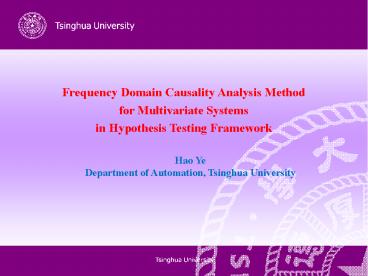Frequency Domain Causality Analysis Method PowerPoint PPT Presentation
Title: Frequency Domain Causality Analysis Method
1
Frequency Domain Causality Analysis Method for
Multivariate Systems in Hypothesis Testing
Framework
Hao Ye Department of Automation, Tsinghua
University
2
Outline
- A Brief Introduction to Causal Analysis
- Two Problems of PDC
- Frequency Domain Causal Analysis Methods Based on
Two Statistics - Simulation Examples
- Concluding Remarks
3
A Brief Introduction to Causal Analysis
- Causal relationship among the time series of an
industrial process is of great use for fault
detection, alarm management, synthesis design,
and modeling, etc. - But it is often complicated and unknown in case
of lack of a perfect knowledge of system
structure
Wiener(1956) Concept based on
data Granger(1963) Granger causality Geweke(1982)
Conditional Granger causality
Time domain
Causality Analysis methods
Frequency domain
Kaminski(1991) Frequency domain Granger
causality Baccala(2001) Partial directed
coherence (PDC)
- Wide application
- Some issues still need further discussions
4
A Brief Introduction to Causal Analysis
-
,
5
Two Problems of PDC
-
,
Baccala and Sameshima (2001) PDC has the
ability to rank the relative interaction strength
with respect to a given signal source because of
the normalization.
Reference (Barrett and Seth, 2009) Granger
causality can measure the strength
Problem 1 PDC cannot correctly rank the causal
strength
6
Two Problems of PDC
Few conclusions about what information the
distribution of PDC in frequency domain can
further offer. It is natural to guess that it
represent how the strength of causal influence
changes with ?.
monotonically decreases as ? grows
Can be extended to a general first order
multivariate system
monotonically increases as ? grows
- Only affects the dynamics of x5
- Does not affect the qualitative causal
relationship
Problem 2 PDC cannot describe how the causal
strength changes with frequency
7
Frequency domain Causal Analysis Methods based on
Two Statistics
Baccala and Sameshima (2001) Due to the
normalization, PDC(xj?xi) may change if more
(or less) signals are influenced by xj, reflects
the relative rather than the absolute strength of
influence
- Schelter et al. (2009) Renormalized PDC (RPDC)
- Schelter et al. (2009) Statistical property of
RPDC - Schelter et al. (2009) Detection rule
How to measure the strength of causality from xj
to xi at ? was not discussed
8
Frequency domain Causal Analysis Methods based on
Two Statistics
RPDC can be directly used to measure the
strength of causality from xj to xi at ?
Greater probability under null hypothesis
Smaller probability under null hypothesis
Stronger causal strength
Weaker causal strength
measure the strength of the causality between
each pair of time series
9
Frequency domain Causal Analysis Methods based on
Two Statistics
(Schelter et al.,2005) To solve the over
fitting problems in model estimation
Lower computation load compared with RPDC
- Schelter et al. (2005)
- Statistical property
Measure the strength of causality from xj to xi
at ?
Measure the strength (and the existence) of the
causality between each pair of time series
10
Simulation Examples
11
Simulation Examples
-
,
SPRDC
Granger causality
24.5012
39.2280
27.7010 32.0942
16.2684 19.6765 15.7450
22.9304
0.2002
0.3932
0.2099 0.3056
0.1088 0.1175 0.0998
0.1951
S?
The calculated strengths based on SPRDC and S?
are consistent with those given by Granger
causality
33.0849
43.8977
38.8698 39.5011
22.1023 26.9955 19.9758
32.8947
12
Simulation Examples
monotonically decreases as ? grows
monotonically increases as ? grows
The distributions of RPDC or
of these two processes are roughly similar as
expected
13
Simulation Examples
Frequency ?/0.01 p (0 to p ) Granger causality
The distribution of Granger causality in the
frequency domain is consistent with those given
by PRDC and ?-statistics
14
Concluding Remarks
Discussion of Problem 1 PDC cannot correctly
rank the causal strength (contribution)
Discussion of Problem 2 PDC cannot describe how
the causal strength changes with frequency
(contribution )
- Solve the two problems respectively (clear
physical meaning in the hypothesis testing
framework, simulation examples ) - Complex computation
Baccala and Sameshima (2001) PDC reflects the
relative rather than the absolute strength of
influence
(Schelter et al.,2005) To solve the over
fitting problems in model estimation
- Similar advantages to PRDC
- Simpler computation
15
Concluding Remarks
- Zhang J, Yang F, Ye H. Frequency domain causality
analysis method for multivariate systems in
hypothesis testing framework. The 19th IFAC World
Progress, 2014

